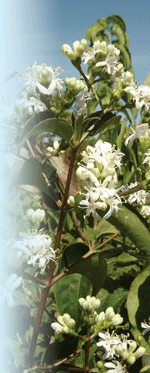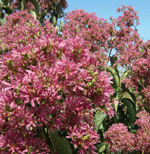Uncommon Shrub With Seasonal Interest
go.ncsu.edu/readext?234320
en Español / em Português
El inglés es el idioma de control de esta página. En la medida en que haya algún conflicto entre la traducción al inglés y la traducción, el inglés prevalece.
Al hacer clic en el enlace de traducción se activa un servicio de traducción gratuito para convertir la página al español. Al igual que con cualquier traducción por Internet, la conversión no es sensible al contexto y puede que no traduzca el texto en su significado original. NC State Extension no garantiza la exactitud del texto traducido. Por favor, tenga en cuenta que algunas aplicaciones y/o servicios pueden no funcionar como se espera cuando se traducen.
Português
Inglês é o idioma de controle desta página. Na medida que haja algum conflito entre o texto original em Inglês e a tradução, o Inglês prevalece.
Ao clicar no link de tradução, um serviço gratuito de tradução será ativado para converter a página para o Português. Como em qualquer tradução pela internet, a conversão não é sensivel ao contexto e pode não ocorrer a tradução para o significado orginal. O serviço de Extensão da Carolina do Norte (NC State Extension) não garante a exatidão do texto traduzido. Por favor, observe que algumas funções ou serviços podem não funcionar como esperado após a tradução.
English
English is the controlling language of this page. To the extent there is any conflict between the English text and the translation, English controls.
Clicking on the translation link activates a free translation service to convert the page to Spanish. As with any Internet translation, the conversion is not context-sensitive and may not translate the text to its original meaning. NC State Extension does not guarantee the accuracy of the translated text. Please note that some applications and/or services may not function as expected when translated.
Collapse ▲
Heptacodium miconioides
Sean P. Bostic, Hunters Branch Farm LLC ©
Finding a distinctive tree or shrub that brings a stellar display to any fall and winter garden could not be any more rewarding than with the seven-son flower, Heptacodium miconioides. Fragrant flowers, beautiful fruits and showy bark bring out the best in every garden’s design and are conveniently packaged in this specimen.
Buds appear in early summer and are almost forgotten until clusters of seven small flowers cover the entire canopy in fragrant, white petals every September. After the veil of white fades, the flower’s sturdier calyx wraps rounded seeds in vivid colors of cherry red to rose purple.
Winter brings the opportune moment to reveal the beautiful exfoliating bark. Stems as small as ½ inch can have their gray-brown bark peel back to show a lighter, inner surface, most evident in the colder months when the plant is without its deciduous canopy.
Heptacodium miconioides can grow 10- to 20-feet tall and half as wide in fountain-like shrub or single-trunk tree forms, depending on the gardener’s choice and pruning. This moderately fast grower thrives in a range of soils from poor to rich, while preferring not to dry out completely.

Heptacodium miconioides
Sean P. Bostic, Hunters Branch Farm LLC ©
All of these features combine to make this a versatile specimen or complimentary plant with a relatively small footprint for a focus in a somewhat-shaded urban garden or as a standout in a much larger design.
A rare native of eastern China, this plant was introduced to the U.S. by the Arnold Arboretum in 1980 and is popular in New England.
This member of the honeysuckle family is not an aggressive self-propagator, but is easily transplanted from containers.
Find a fine example of this plant in specialized garden centers and the southeast section of the JC Raulston Arboretum in the magnolia and barberry peninsula near the weeping, winged elm.


